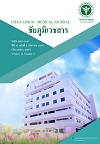A comparative study of the effect of clinical practice guideline for management acute exacerbation in chronic obstructive pulmonary disease patients on acute respiratory failure and length of stay in Phukieochalermprakiat Hospital, Chaiyaphum Province
การศึกษาเปรียบเทียบผลการใช้แนวปฏิบัติทางคลินิกของอาการหอบกำเริบเฉียบพลันในผู้ป่วยโรคปอด อุดกั้นเรื้อรังต่อภาวะการเกิดทางเดินหายใจล้มเหลวเฉียบพลัน และวันนอนโรงพยาบาล ในโรงพยาบาลภูเขียวเฉลิมพระเกียรติ จังหวัดชัยภูมิ
บทคัดย่อ
Background : Chronic Obstructive Pulmonary Disease ( COPD ) is still remains a leading cause of high morbidity and mortality. Goal of treatment are decrease symptom and prevent future risks ( prevention and treatment of acute exacerbation, complication)
Objective : To compare the effect of clinical practice guideline for management acute exacerbation in chronic obstructive pulmonary disease patients at Phukieochalermprakiat Hospital, Chaiyaphum Province
Method and material : The research is a retrospective study that compare the percentage of acute
respiratory failure , length of stay before(the data were collected from 1 January 2561 – 31 December 2561) and after (the date collected from 1 January 2562 – 31 December 2562) usage of the clinical practice guideline for management acute exacerbation in chronic obstructive pulmonary disease patients in Phukieochalermprakiat Hospital, Chaiyaphum Province.The data was retrieved from the medical records including age, gender, precipitating factor, treatment, length of stay and acute respiratory failure.
Result : The hospitalized COPD patients with acute exacerbation in this study were 64 cases (109 admissions) before using the clinical practice guideline and 64 cases (99 admissions) after using guideline. The most precipitating factor of acute exacerbation is respiratory tract infection. The average length of stay before and after using guideline are 3.3 ± 3.39 days , 1.97 ± 0.92day ( p < 0.001) in consequently. The percentage of acute respiratory failure is not different between both groups 1.4% (no clinical practice) vs 1% (clinical practice guideline) (P = 0.739). In addition, the 28-day readmission rate is decrease from 7.2% to 2.9% ( p = 0.069 ).
Conclusion : Treatment of COPD with acute exacerbation with antibiotics is impact on length of stay but not impact on acute respiratory failure.
Key word : Chronic Obstructive Pulmonary Disease, acute exacerbation, Acute respiratory failure, length of stay
ความเป็นมา : โรคปอดอุดกั้นเรื้อรังยังเป็นสาเหตุสำคัญที่นำไปสู่การเจ็บป่วยและการเสียชีวิตของคนทั่วโลก เป้าหมายของการรักษาโรคปอดอุดกั้นเรื้อรัง คือ ลดอาการในปัจจุบัน (ลดอาการหอบเหนื่อย ออกกำลังให้ได้นานขึ้น) และ การป้องกันสิ่งที่จะเกิดในอนาคต (ป้องกันและรักษาอาการกำเริบ หรือภาวะแทรกซ้อน) การดูแลรักษาภาวะหอบกำเริบเฉียบพลันที่ดีจะทำให้ไม่มีภาวะแทรกซ้อน ลดอัตราการเสียชีวิต
วัตถุประสงค์ : การศึกษาเปรียบเทียบผลการใช้แนวปฏิบัติทางคลินิกของอาการหอบกำเริบเฉียบพลันในผู้ป่วยโรคปอดอุดกั้นเรื้อรังต่อการเกิดทางเดินหายใจล้มเหลวเฉียบพลัน และวันนอนโรงพยาบาล ในโรงพยาบาลภูเขียวเฉลิมพระเกียรติ จังหวัดชัยภูมิ
วิธีการศึกษา : การศึกษานี้เป็นการวิจัยแบบเชิงพรรณนาย้อนหลัง (Retrospective study) เพื่อศึกษาแนวปฏิบัติทางคลินิกของอาการหอบกำเริบเฉียบพลันในผู้ป่วยโรคปอดอุดกั้นเรื้อรังก่อนและหลังใช้ ก่อนใช้แนวปฏิบัติ ระหว่างวันที่ 1 มกราคม 2561 - วันที่ 31 ธันวาคม 2561 เปรียบเทียบกับหลังใช้ ระหว่าง 1 มกราคม 2562 - วันที่ 31 ธันวาคม 2562 ทำการบันทึกข้อมูลส่วนบุคคล การรักษา และผลของการรักษา
ผลการศึกษา : ผลของการศึกษาก่อนใช้แนวทางปฏิบัติมีทั้งหมด 64 คน รับไว้รักษาในหอผู้ป่วยอายุรกรรมทั้งหมด 109 ครั้ง หลังจากใช้แนวปฏิบัติ มีจำนวนทั้งหมด 64 คน รับไว้รักษาทั้งหมด 99 ครั้ง สาเหตุของหอบกำเริบเฉียบพลันคือการติดเชื้อ เช่น เสมหะมากขึ้น เสมหะเปลี่ยนสี ไข้ ซึ่งระยะเวลาการนอนโรงพยาบาลก่อนใช้แนวปฏิบัติ 3.3 ± 3.39 วัน หลังจากใช้แนวปฏิบัติ 1.97 ± 0.92 วัน (p < 0.001) ภาวะทางเดินหายใจล้มเหลวเฉียบพลันก่อนใช้แนวปฏิบัติคิดเป็นร้อยละ 1.4 หลังใช้คิดเป็นร้อยละ 1 ( p = 0.739 ) อัตราการกลับมานอนโรงพยาบาลภายใน 28 วันลดลงจากร้อยละ 7.2 เป็น 2.9 ( p = 0.069 )
สรุป : จากการศึกษานี้ การใช้แนวปฏิบัติทางคลินิก ในภาวะหอบกำเริบเฉียบพลันในผู้ป่วยโรคปอดอุดกั้นเรื้อรังสามารถอาการหอบกำเริบเฉียบพลัน ลดระยะเวลาการนอนโรงพยาบาลได้ แต่ไม่มีผลต่ออัตราการเกิดภาวะทางเดินหายใจล้มเหลวเฉียบพลัน
คำสำคัญ: โรคปอดอุดกั้นเรื้อรัง ภาวะกำเริบเฉียบพลัน ทางเดินหายใจล้มเหลวเฉียบพลัน ระยะเวลาการนอนโรงพยาบาล
ดาวน์โหลด
เผยแพร่แล้ว
เวอร์ชัน
- 2021-08-17 (3)
- 2021-08-02 (2)
- 2021-02-09 (1)
ฉบับ
บท
การอนุญาต
ลิขสิทธิ์ (c) 2021 ชัยภูมิเวชสาร

This work is licensed under a Creative Commons Attribution-NonCommercial-NoDerivatives 4.0 International License.





